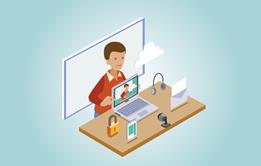By using a variety of interaction patterns, online learning can become much more dynamic. This article lists the advantages and tips of a key part of online learning: breakout rooms.
One of the great advantages of teaching online is that you have access to a worldwide web of resources literally at your fingertips. You can draw your students’ attention to anything that supports your teaching. However, in the online environment, it is also harder to be sure of where your students’ attention is exactly. This is why it is important to have a variety of interaction patterns: whole class, pair work, and group work.
Whole class activities mean that you are talking to all of the students at once. These activities are an excellent way to activate interest in a subject or to address the class in a feedback session. You can use the microphone and wait for students to respond but in large groups, it may be more convenient to use the chat window and react to the students’ responses. For short periods, this is an excellent way to control the pace of an online class.
However, by including pairwork and groupwork activities where students are working by themselves for a set period of time, you can have varied exercises and ensure that students are more focussed. In an online environment, pairwork and groupwork activities take place in what is called “a breakout room”, where students break out from the main room into smaller subgroups (or pairs) in a separate room, and then rejoin the main room when the teacher decides.
Different platforms have different ways of managing breakout rooms. However, the typical situation is that the teacher creates the main room and the breakout rooms before the class begins. During the class, the teacher announces that there will be a separate activity with a clear task and a set time limit. Then, the teacher assigns students to the different breakout rooms. Depending on the platform, the teacher may be able to broadcast messages to the breakout rooms and most platforms allow the teacher to visit the breakout rooms and monitor the conversations. Once the task is complete or the time limit has been reached, the teacher reassigns the students back to the main room and there is some feedback on the task.
Advantages of breakout rooms
- Communication—In breakout rooms, students can speak to each other and work on a task. This means they get much more speaking practice and also the communication has a focus.
- Attention—Working on a task means that students are more likely to pay attention especially as their peer group will be encouraging them to participate.
- Interaction patterns—It is important to vary the class structure to keep it motivating, so you will need to move from whole class, to pairs, to groups, to individual presentations.
Tips when working with breakout rooms
- Prepare your breakout room in advance—Set up your breakout rooms and give them a name. That will help you when you are assigning students to rooms. Depending on the platform you may be able to have text waiting in the room for when they arrive. If not, you can always send links to students and make different links for different groups.
- Make sure the task and time limit are clear—You could ask more confident students to explain the task to the others. Another way to check is by asking questions: How many questions do you need to answer? How long do you have to work on the questions?
- Allow time for moving students into and out of breakout rooms—Especially the first time, it can take a little bit of time to assign students to the different rooms. It is good to plan for this.
- Allow time for students to get used to the main room—Moving from a breakout room to the main room implies that suddenly what you say on your microphone can be heard by the complete group.Make sure students understand this so that it is not a surprise when they move. Being in a separate room is fantastic for encouraging communication, but moving from a separate room to the main room can feel strange.
- Plan time for feedback after tasks—It takes time for each pair or each group to feedback to the class. You may want to nominate students to represent their breakout room so that the feedback time is quicker. You may simply want to include that extra time in your plan.
So build breakout rooms into your lesson plans and if you are using the lesson plans provided by the onestopenglish team, just know that when it refers to pair work and group work, you can use breakout rooms for your virtual version.
Introduction to Tech Tools

Tech experts Nik Peachey and Tom Walton present an invaluable series on using technology in the classroom.
- 1
- Currently reading
Tech Tools for Teachers: Managing class interaction in online learning
- 3
- 4
- 5
- 6
- 7
- 8
- 9









2 Readers' comments